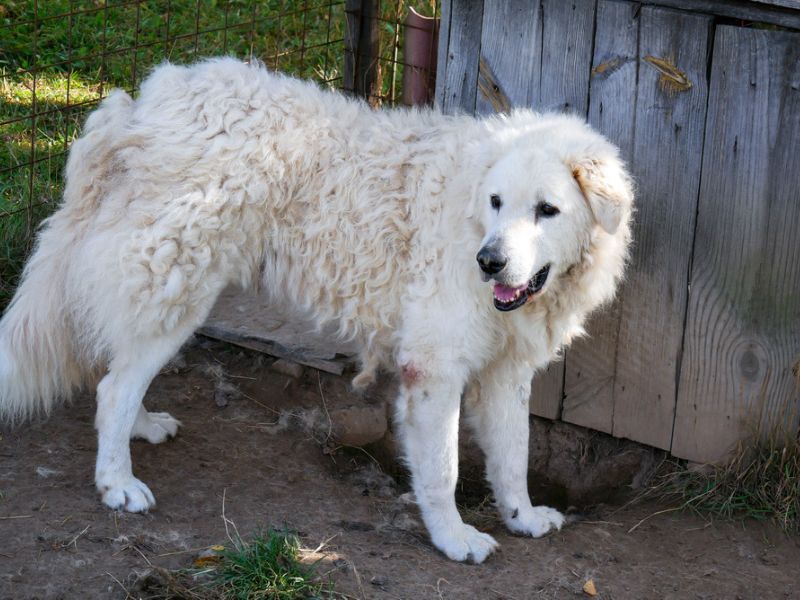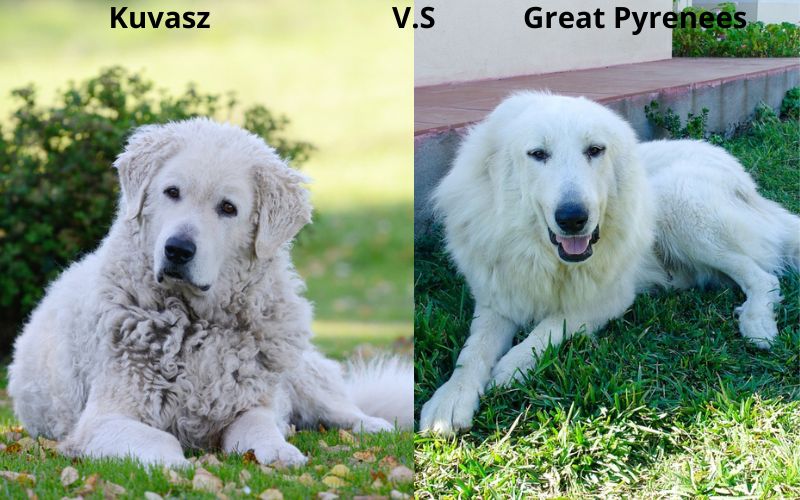Kuvasz and Great Pyrenees differ in many ways. The first significant difference between them is their origin. Kuvasz originated from Hungary, while the Great Pyrenees came from the Pyrenees Mountains on the border between Spain and France. By looking at their coat color, you can also distinguish the Kuvasz from the Great Pyrenees.
The Great Pyrenees are predominantly white, and the white will usually have various color patches. The dog can be white and have gray, tan, or reddish-brown badger marks on the head, ears, body, or tail. On the other hand, a Kuvasz is primarily white or ivory. Despite the color differences, Kuvasz and the Great Pyrenees share some similarities.
For instance, they are both large to giant dogs. They also have thick coats. You will learn the other similarities in the next section. I’ve also explained the key differences between the Kuvasz and the Great Pyrenees in this article below. After reading this, you will have no problem distinguishing between the two dogs.
Are Kuvasz and Great Pyrenees dogs similar?

The first significant similarity between the two dogs is size.
They are both large dogs, growing to 25 and 32 inches tall. That means the dog’s diet is also pretty much the same. The Kuvasz and Great Pyrenees will benefit from dog food for large dogs.
Secondly, both the Kuvasz and the Great Pyrenees have a thick coat. Therefore, both dog breeds require significant care concerning grooming. Nevertheless, the dense undercoat protects the Kuvasz and Great Pyrenees from hot and cold temperatures.
The thick coat also plays an essential role in repelling moisture and dirt.
The third similarity between Kuvasz and the Great Pyrenees is their lifespan. Either of them will live between 8 and 12 years if you give them proper care. That includes essential grooming and regular baths. Use recommended dog tools to care for the dogs.
Avoid human soaps or brushes when grooming the Kuvasz or Great Pyrenees. Otherwise, you may encourage itching and shedding in your dog. Use dog shampoos and dog brushes to wash their coat. Ensure there are no toxic ingredients in the ingredients you choose to use.
Kuvasz vs Great Pyrenees – How to Tell the Difference

Here is how to tell the difference between the Kuvasz and the Great Pyrenees:
1. Size and weight
Although they are large dog breeds, the Kuvasz and the Great Pyrenees vary in size and weight. The Great Pyrenees is the largest and can grow to 32 inches tall.
On the other hand, Kuvasz can be one or two inches shorter, reaching a maximum size of 30 inches. Similarly, adult Kuvasz dogs weigh between 80 and 115 pounds, while the Great Pyrenees weigh between 85 and 150 pounds.
2. Physical differences
The easiest way to differentiate between a Kuvasz and the Great Pyrenees is by looking at their physical differences. That includes coat color, head shape, eyes, and ear arrangement.
As per color, Kuvasz is either all white or ivory. On the other hand, the Great Pyrenees has gray, tan, or reddish-brown badger marks on the head, ears, body, or tail. Also, the Great Pyrenees have a black nose and dark-brown eyes.
The Great Pyrenees has a broad and blocky head, while the Kuvasz’s head is not as wide. Besides, the Kuvasz’s head comes to a slight stop while the Great Pyrenees’ head comes to a more pronounced stop.
3. Lifespan
There are no significant differences in the lifespan of the Kuvasz and the Great Pyrenees. Although they are susceptible to many dog diseases (see health issues below), the Kuvasz and Great Pyrenees can live up to 12 years old.
According to recent veterinary records, dogs weighing over 90 pounds live much shorter lives than dogs weighing under 20 pounds. Due to the size of the Kuvasz and Great Pyrenees, reaching their whole lifespan might be difficult.
In other words, the lifespan of your Kuvasz or Great Pyrenees depends significantly on the quality of care you give the dogs. However, give the dogs high-quality dog food, training, and exercise if you want them to live to their lifespan. Feed the Kuvasz or the Great Pyrenees twice a day, preferably in the morning and evening.
Most importantly, take the dogs to the vet every month or two for medical checkups.
4. Shedding
As I discussed earlier, both Kuvasz and Great Pyrenees dogs have thick coats. Although the skin is an essential thermoregulator in hot and cold environments, the two dog breeds can be more susceptible to shedding, especially in the summer. However, caring for the Kuvasz is not difficult because the specks of dirt on its hair will usually dry and fall off on their own. In other words, the Kuvasz self-cleans.

Whereas the Great Pyrenees are moderate to heavy shedders, the Kuvasz shed profusely. If you keep either of them, expect dog hair on your furniture, clothes, and car. However, you will see more shedding in the dogs during spring and fall.
Despite the shedding, there are many ways to reduce it. For instance, bathe the Kuvasz and the Great Pyrenees occasionally during the summer and brush their hair to remove dead hair and dander. Also, cover or vacuum your home and car seats frequently.
If you are allergic to dog hair and dander, I’d recommend the Kuvasz. Whereas the Great Pyrenees is not hypoallergenic, the Kuvasz is more forgiving in that regard.
5. Care and grooming
Since the Kuvasz and the Great Pyrenees are large fluffy dogs, caring for them can be challenging. First, the dogs have moderate to high energy levels. Although the Kuvasz’s exercise needs are not as much as that of the Great Pyrenees, they both need the exercise.
Therefore, the first care area involves offering them enough space for activity. Otherwise, the dogs can get bored and channel their energy into destructive habits. Take the dogs for one hour’s walk daily. In the next section, learn how to train the Kuvasz and the Great Pyrenees.
Grooming the Kuvasz and the Great Pyrenees involves brushing, bathing, drying, trimming, clipping, and sanitizing the dogs. Comb the dog’s hair before the bath and repeat the brushing afterward. Use a dog shampoo to lather their coat quickly.
Trim or clip their nails every one or two weeks but avoid clipping the dog fur. Cutting their hair can subject the dog to extreme heat or cold.
6. Trainability
The Kuvasz dog is moderate to highly trainable, while the Great Pyrenees is highly trainable. Therefore, training a Kuvasz requires significant patience and consistency. I don’t recommend the Kuvasz to new dog owners. The dog needs a strong leader to keep it in line.
On the other hand, training the Great Pyrenees requires the least effort. Generally, teaching the dog from an early age and using positive reinforcements yields the best results. Teach the Kuvasz and the Great Pyrenees from six months old.
Start with basic dog commands like COME, SIT, STAY, DOWN, OFF, and NO. As you will learn later in this article, the Great Pyrenees’ is sensitive. So don’t shout or hit your Pyrenees during training. Hire a dog trainer for the Kuvasz if you don’t have enough patience or time.
7. Temperament
The Kuvasz and the Great Pyrenees are great family dogs. Both dogs were historically used as guard dogs for homes and livestock. Therefore, Kuvasz and Great Pyrenees are protective dogs.
However, I recommend leaving the dog with older children, not toddlers. Although the Kuvasz and the Great Pyrenees will not harm a toddler, it is best practice to monitor a toddler when associating with these giant dogs.
8. Health issues
Some common health issues in Kuvasz and Great Pyrenees dogs include:
- Canine hip dysplasia
- Skin problems
- Hypothyroidism
- Osteochondritis Dissecans (OCD)
Here is a summary of the differences between the Kuvasz and the Great Pyrenees:
| Kuvasz | The great Pyrenees | |
| Size (inches) | 26 to 30 | 25 to 32 |
| Weight (pounds) | 80 to 115 | 85 to 150 |
| Common color | White or ivory | Dominantly white, with colored patches. |
| Coat type | Double coat | Double coat |
| Temperament | Gentle, protective | Calm, serious, well-mannered |
| Trainability | Moderate to highly trainable | Highly trainable |
| Life expectancy (years) | 10 – 12 | 10 – 12 |
| Barking | Don’t often bark | Barks a lot |
Key difference
The key differences between Kuvasz and the Great Pyrenees are color, size, trainability, and temperament. Kuvasz dogs can be one or two inches smaller than Great Pyrs. Also, Kuvasz dogs are either all white or ivory.
On the contrary, the Great Pyrenees have other color markings. Regarding temperament, both dogs are family-friendly, but the Great Pyrenees will bark more often than the Kuvasz.
References
Case Western Reserve University. (2018). The Pyrenees. Institute for the Science of Origins.
UC Davis Veterinary Medicine. (2022) Kuvasz. Veterinary Genetics Laboratory.